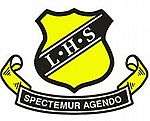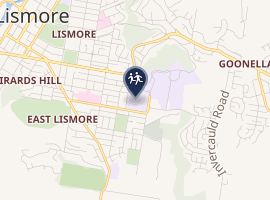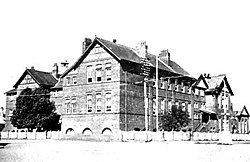Lismore High Campus
Lismore High Campus, part of The Rivers Secondary College, is a government-funded co-educational comprehensive secondary day school campus, located on Dalley Street, East Lismore, in the Northern Rivers region of New South Wales, Australia.
| Lismore High Campus (part of The Rivers Secondary College) | |
|---|---|
 | |
| Location | |
 Lismore High Campus (TRSC) Location in New South Wales | |
Australia | |
| Coordinates | 28°49′13″S 153°17′49″E |
| Information | |
| Type | Government-funded co-educational comprehensive secondary day school campus |
| Motto | Latin: Spectemur Agendo (Let us be judged by our actions.) |
| Established | January 1920[1] |
| School district | Lismore; Regional North |
| Educational authority | NSW Department of Education |
| Principal | Chris Williams[2] |
| Years | 7–12 |
| Enrolment | ~400[3] (2018) |
| Campus type | Regional |
| Colour(s) | Gold and black |
| Website | lismore-h |
| [4] | |

| |
Established in 1920 as Lismore High School, the campus enrolled approximately 400 students in 2018, from Year 7 to Year 12, of whom 17 percent identified as Indigenous Australians and six percent were from a language background other than English.[3] The school is operated by the NSW Department of Education; the principal is Chris Williams.[2]
The Rivers Secondary College comprises the Richmond River High Campus, the Kadina High Campus, and the Lismore High Campus.
History and description
First location
Previously known as Lismore High School (LHS), the school's first site was on Lake Street, North Lismore (the present Richmond River High Campus site).[5] On 23 November 1918, the foundation stone was laid for the new high school building by the Member for Lismore, George Nesbitt.[6] At the time of its establishment in January 1920, it was one of only five high schools outside the Sydney metropolitan area.[lower-alpha 1] The school served the Richmond River area and until 1929 with the opening of Murwillumbah High School, was the only high school between Grafton and the Queensland border.
The Chinese-Australian journalist Vivian Chow Yung[lower-alpha 2] attended LHS in its beginning years. Told in 1923 by an Irish-Australian schoolteacher at LHS, "You are Australian now. Why worry so much about China? What does China mean to you?", Chow responded "Sir, you were born in Australia, but you are always telling us about Home Rule for Ireland. What does Ireland mean to you?"[7][lower-alpha 3]
Second location

The second site of LHS was on Magellan Street in the city precinct. By 1957 LHS was one of the largest secondary schools in the state, with an enrolment of 1,438 students and a staff of 67 teachers.[8] This represented the zenith of its enrolments as the establishment of other high schools took effect: Kyogle (1955), Mullumbimby (1955), Ballina (1956) and Richmond River (1958). The writer Bob Ellis attended LHS at this time. In a speech in May 1998, Ellis acknowledged the "selfless teachers I am proud to have known" and that "Lismore High gave us not only the intellectual armaments that made it possible for us to prevail in the great world beyond Lismore, but it also gave us a sense of that possibility".[9]
Third location
By the late 1960s, the Magellan Street site of the school was proving to be too small for its requirements and in May 1969 LHS moved to its third site, a new complex in East Lismore. LHS, once the only high school in the district, is now one of three state, two Catholic and two Independent High Schools in Lismore.[lower-alpha 4] Enrolments are now relaxed at around 400 students.[3][4]
The Magellan Street site has been used for educational purposes since 1882. It was originally a paddock when the Lismore Public School, established in 1867, moved there that year. The children were housed in school tents until in August 1885 they moved into a new brick building with stone foundations. From 1890 the school offered primary and secondary education, becoming the Lismore Superior School. In 1902, when the northern end of the 1885 building became unsafe, a three-storey brick building, with a covered play area on the ground floor, was built and occupied by the Girls’ Department in August 1903.[8]
Not long afterwards, most of the remaining 1885 building was demolished. The Boys’ Department of the Lismore District School was housed in a temporary wooden building until December 1911, when it moved into a two-storey brick extension at the Keen and Magellan Streets corner. During the 1920s and 1930s allotments were acquired progressively until the whole area bounded by Keen, Magellan and Dawson Streets was available for school purposes, now home to Lismore Public School and Lismore High School.[1] In February 1931 a third building opened. In 1942 Lismore Public School moved to a new complex and the vacated buildings were taken over by LHS.
With the shift of LHS to the East Lismore site, the new Lismore Teachers’ College opened in the Magellan Street site, which became from 1971 the Northern Rivers College of Advanced Education, which also housed the Northern Rivers Conservatorium Arts Centre. The college moved later to the north of the new East Lismore site to become the Lismore Campus of Southern Cross University.[8]
The 1902 school buildings on Keen Street continue to house the Northern Rivers Conservatorium Arts Centre today while various other buildings were demolished. The 1931 building on Magellan Street was retained and in 2003 became home to the Lismore City Library and various other community services.[10]
Notable alumni
- Peter Arnison AC, CVO – Major General, Land Commander Australia 1994–1996, Governor of Queensland 1997–2003
- Ken Buttrum – former head of the Department of Juvenile Justice of New South Wales
- Vivian Chow Yung – journalist. Founder of the "United China Magazine" in Shanghai and Foreign Affairs Editor of the "Sin Wian Pao" newspaper in Shanghai in the 1930s
- Bruce Duncan – first ex-student to become Member for Lismore (1965–1988) in the New South Wales Legislative Assembly
- Bob Ellis – writer, journalist and political commentator
- David Ellyard – science broadcaster and weatherman
- Paul Hockings – author, editor, filmmaker, and Professor of Anthropology at the University of Illinois
- Roy Masters AM – football coach
- Pat Morton – former politician; leader of the NSW Opposition (1955–1959) and Askin Cabinet Minister
- John Niland AC – former Vice Chancellor of the University of New South Wales 1992–2002
- Richard Nott AM – former President Australia-Britain Society, Australian Rep Friends of St. George's, CEO CGULMI 2001–2012, MD Australia MGICA 2012–16 At LHS 1954–56
- Frank Oakes – first ex-student to become Mayor of Lismore[11] Oakes Oval in Lismore is named after him.
- Bill Rixon – politician; Member of NSW Parliament for Lismore (1988–1999)
- George Sharpe – judge of the Supreme Court of New South Wales 1989–1993[12]
- Isaac Smith – Deputy Mayor of Lismore City Council and Councillor since September 2008[13]
- Richard Stratford – headmaster Sydney Boys' High School 1992–1999
- Douglas G. Stuart – Regents' Professor Emeritus of Physiology, The University of Arizona[14]
- Harry Wharton OBE, FAA – zoologist and entomologist, particularly for the CSIRO[15][16]
Notes
- The others were Maitland (1884), Grafton (1912), Goulburn (1913) and Wollongong (1917).
- The naming protocol used is the European given name Vivian followed by the Chinese surname Chow followed by the Chinese given name Yung. Because of misunderstanding of Chinese naming protocols, the Chinese given name was often misused in official documents as a surname, and thus Vivian Chow is often referred to as Vivian Yung.
- Chow is also frequently mentioned in Professor John Fitzgerald's Big White Lie: Chinese Australians and White Australia (2007) Sydney, UNSW Press.
- Richmond River High School in North Lismore opened in 1958, and Kadina High School in Goonellabah opened in 1977.
References
- "Lismore High". Government Schools of New South Wales from 1848. NSW Education and Communities. Retrieved 28 June 2011.
- "Principal's welcome". The Rivers Secondary College, Lismore High Campus. NSW Department of Education. n.d. Retrieved 20 July 2019.
- "The Rivers Secondary College, Lismore High Campus, Lismore, NSW: School profile". My School. Australian Curriculum, Assessment and Reporting Authority. 2019. Retrieved 20 July 2019.
- "Lismore High School". School Locator. NSW Public Schools. Retrieved 28 June 2011.
- The Lens Journal of Lismore High. 1963. p. 22.
- "Lismore High School". The Brisbane Courier. Australian National Library. 25 November 1918. p. 9. Retrieved 28 June 2011.
- Chow, Vivian (December 1932). "China in Revolution" (Radio address)
|format=requires|url=(help) (Interview). Brisbane: 4QG. Quoted in Celestials in a Great Garden by Glen Hall (1975) Richmond River Historical Society, Lismore - "About Us". Northern Rivers Conservatorium Arts Centre (NRCAC). Archived from the original on 2 April 2011. Retrieved 28 June 2011.
- Ellis, Bob (30 March 2012). "Classic Ellis: A State School Education, A Speech To Some High School Teachers, May 1998". Boban Services Pty Ltd. Archived from the original on 31 March 2012. Retrieved 31 March 2018.
- "Lismore City Library". Richmond-Tweed Regional Library. Archived from the original on 23 April 2011. Retrieved 28 June 2011.
- The Lens (Journal of LHS). 1966. p. 31.
- (1989) 63 Australian Law Journal 712.
- "Councillor Isaac Smith". Lismore City Council. Archived from the original on 5 April 2011. Retrieved 28 June 2011.
- "Douglas Stuart - Department of Physiology". The University of Arizona. Archived from the original on 16 March 2012. Retrieved 28 June 2011.
- "Wharton, Ronald Harry (1923 – 1983)". Encyclopaedia of Australian Science. Retrieved 28 June 2011.
- "Biographical memoirs - Ronald Harry Wharton". Australian Academy of Science. Archived from the original on 6 August 2011. Retrieved 28 June 2011.
External links
- Official website
- New South Wales Department of Education and Training - Lismore High School
- NSW Schools website